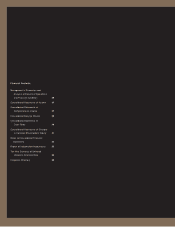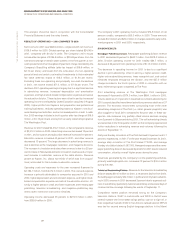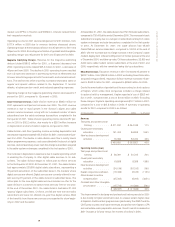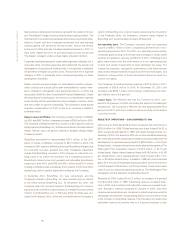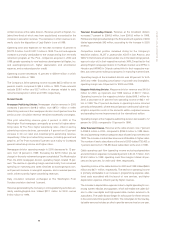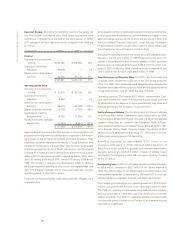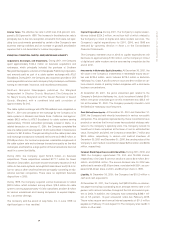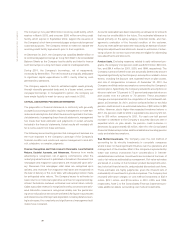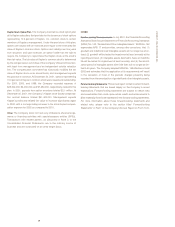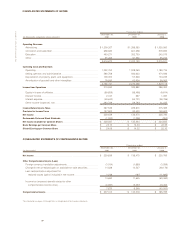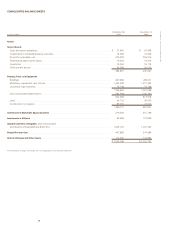Washington Post 2001 Annual Report Download - page 8
Download and view the complete annual report
Please find page 8 of the 2001 Washington Post annual report below. You can navigate through the pages in the report by either clicking on the pages listed below, or by using the keyword search tool below to find specific information within the annual report.
35
The Company’s five-year $500 million revolving credit facility, which
expires in March 2003, and one-year $250 million revolving credit
facility, which expires in September 2002, support the issuance of
the Company’s short-term commercial paper and provide for general
corporate purposes. The Company intends to extend or replace the
revolving credit facility agreements prior to their expiration.
At December 30, 2001, the Company has classified $483.9 million of
its commercial paper borrowings as “Long-Term Debt” in its Consolidated
Balance Sheets as the Company has the ability and intent to finance
such borrowings on a long-term basis under its credit agreements.
During 2001, the Company’s borrowings, net of repayments,
increased by $9.8 million. The net increase is principally attributable
to significant capital expenditures in 2001, mostly offset by cash
generated by operations.
The Company expects to fund its estimated capital needs primarily
through internally generated funds and, to a lesser extent, commer-
cial paper borrowings. In management’s opinion, the Company will
have ample liquidity to meet its various cash needs in 2002.
CRITICAL ACCOUNTING POLICIES AND ESTIMATES
The preparation of financial statements in conformity with generally
accepted accounting principles requires management to make esti-
mates and assumptions that affect the amounts reported in the finan-
cial statements. In preparing these financial statements, management
has made their best estimates and judgments of certain amounts
included in the financial statements. Actual results will inevitably dif-
fer to some extent from these estimates.
The following are accounting policies that management believes are
the most important to the Company’s portrayal of the Company’s
financial condition and results and require management’s most diffi-
cult, subjective, or complex judgments.
Revenue Recognition and Trade Accounts Receivable, Less Estimated
Returns, Doubtful Accounts, and Allowances. Revenue from media
advertising is recognized, net of agency commissions, when the
underlying advertisement is published or broadcast. Revenues from
newspaper and magazine subscriptions are recognized upon deliv-
ery. Revenues from newspaper retail sales are recognized upon
delivery, and revenues from magazine retail sales are recognized on
the later of delivery or the cover date, with adequate provision made
for anticipated sales returns. The Company bases its estimates for
sales returns on historical experience and has not experienced sig-
nificant fluctuations between estimated and actual return activity.
Cable subscriber revenue is recognized monthly as services are deliv-
ered. Education revenue is recognized ratably over the period dur-
ing which educational services are delivered. As Kaplan’s businesses
and related course offerings have expanded, including distance-learn-
ing businesses, the complexity and significance of management esti-
mates have increased.
Accounts receivable have been reduced by an allowance for amounts
that may be uncollectible in the future. This estimated allowance is
based primarily on the aging category, historical trends, and man-
agement’s evaluation of the financial condition of the customer.
Accounts receivable have also been reduced by an estimate of adver-
tising rate adjustments and discounts, based on estimates of adver-
tising volumes for contract customers that are eligible for advertising
rate adjustments and discounts.
Pension Costs. Excluding expenses related to early retirement pro-
grams, the company’s net pension credit was $76.9 million, $65.3 mil-
lion, and $84.4 million for 2001, 2000, and 1999, respectively. The
Company’s pension benefit costs are actuarially determined and are
impacted significantly by the Company’s assumptions related to future
events, including the discount rate, expected return on plan assets,
and rate of compensation increases. At December 30, 2001, the
Company modified certain assumptions surrounding the Company’s
pension plans. Specifically, the Company reduced its assumptions on
discount rate from 7.5 percent to 7.0 percent and expected return on
plan assets from 9.0 percent to 7.5 percent. These assumption
changes are incorporated into the computation of the total benefit obli-
gation at December 30, 2001, and the combined effect on the 2002
pension credit amount is an estimated reduction of $20 million to $25
million. However, due to higher than expected investment returns in
2001, the pension credit for 2002 is expected to be down by $10 mil-
lion to $15 million compared to 2001. For each one-half percent
increase or decrease to the Company’s assumed discount rate or
expected return on plan assets, the pension credit increases or
decreases by approximately $5 million. Note H to the Consolidated
Financial Statements provides additional details surrounding pension
costs and related assumptions.
Cost Method Investments. The Company uses the cost method of
accounting for its minority investments in non-public companies
where it does not have significant influence over the operations and
management of the investee. Most of the companies represented by
these cost method investments have concentrations in Internet-
related business activities. Investments are recorded at the lower of
cost or fair value as estimated by management. Fair value estimates
are based on a review of the investees’ product development activi-
ties, historical financial results, and projected discounted cash flows.
These estimates are highly judgmental, given the inherent lack of
marketability of investments in private companies. The Company has
recorded write-down charges on cost method investments of $32.4
million, $23.1 million, and $13.6 million in 2001, 2000, and 1999,
respectively. Note C to the Consolidated Financial Statements pro-
vides additional details surrounding cost method investments.
THE WASHINGTON POST COMPANY

